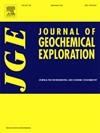原生流体中锂的来源:来自法国上莱茵地陷Soultz-sous-Forêts地热储层的证据
IF 3.4
2区 地球科学
Q1 GEOCHEMISTRY & GEOPHYSICS
引用次数: 0
摘要
自罗马时代以来,上莱茵河地堑的地热盐水就被用作温泉或制盐。自2007年以来,地热发电厂产生热量和电力。最近,它们的高锂含量也引起了经济利益。这种增加的兴趣与我们对地质-热液演化的理解形成对比。我们使用岩石学,主要和微量元素矿物化学和质量平衡计算钻芯,穿过斯特拉斯堡和卡尔斯鲁厄之间Soultz-sous-Forêts的花岗岩地热储层岩石,以阐明储层中的流体-岩石相互作用,该储层被积极用于供热和发电。储层中碱长石和二云母花岗岩具有典型的斜长石、钾长石、石英、黑云母和白云母组合,并伴有钛矿、磷灰石和锆石的点缀。区分出两个热液蚀变事件:(1)长石钠长岩化;(2)长石被绢云母和方解石取代,黑云母被绿泥石和钛矿取代;近端热液脉由绢云母和高岭石代替长石。事件2长石蚀变定量释放Pb和Ba到流体中,而Rb、Cs、Sr和Zn则根据整个岩石和矿物组成的不同表现出不同的行为。事件2黑云母-绿泥石蚀变释放Li、Rb、Cs、Sr、Ba、Zn和Pb到流体中。物质平衡计算表明,Soultz-sous-Forêts地热卤水的Si、Fe、Ca、K、Rb、Sr、Zn、Pb含量可以用储层内的流体-岩石相互作用来解释。然而,为了达到最近的卤水成分,需要浸出的储层岩石体积在不同元素之间会有几个数量级的变化。许多元素可能在热液蚀变过程中被浸出,但特别是Li和Cs需要的流岩比为1/300,这是不切实际的。这些考虑表明Na, Ca, Li, Cs和Ba需要额外的外部来源。在此基础上,我们提出了在热液事件2中已经富含Li、Rb和Cs的中三叠世卤水与储层岩石发生反应,随后与侏罗纪-白垩纪海水混合的模型,并在下沉过程中溶解蒸发岩。这与黑森林中不同地点的侏罗纪-白垩纪伊利石年龄一致,表明这些盐水经历了复杂的~ 150万年的热液演化。Li的来源可能不是单一的,它可能来自于与沉积(蒸发岩)的复杂流体-岩石相互作用,而不太重要的是,上莱茵地堑的结晶地层。与沉积地层相互作用的原生流体的复杂热液史和在深层储层中的保存是锂资源开发的关键。本文章由计算机程序翻译,如有差异,请以英文原文为准。
The source of lithium in connate fluids: Evidence from the geothermal reservoir at Soultz-sous-Forêts, Upper Rhine Graben, France
Geothermal brines in the Upper Rhine Graben have been used as a spa or for salt production since Roman times. Heat and power are generated in geothermal power plants since 2007. Recently, their elevated Li-content has additionally attracted economic interest. This increased interest is in contrast with our understanding of the geological-hydrothermal evolution. We use petrology, major and trace element mineral chemistry and mass balance calculation from drill cores that intersect granitic geothermal reservoir rocks at Soultz-sous-Forêts between Strasbourg and Karlsruhe to shed light on fluid-rock interaction in a reservoir that is actively used for heat and power generation. The alkali feldspar and the two-mica granite in the reservoir have a typical plagioclase, K-feldspar, quartz, biotite and muscovite assemblage with some accessories of titanite, apatite and zircon. Two hydrothermal alteration events are distinguished: (1) albitization of the feldspars; (2) distal replacement of feldspars by sericite and calcite, of biotite by chlorite and titanite; and proximal to hydrothermal veins replacement of the feldspars by sericite and kaolinite. Event 2 feldspar alteration quantitatively releases Pb and Ba to the fluid, whereas Rb, Cs, Sr and Zn show different behaviour depending on whole-rock and mineral composition. Event 2 biotite-chlorite alteration releases Li, Rb, Cs, Sr, Ba, Zn and Pb to the fluid. Mass balance calculation indicates that Si, Fe, Ca, K, Rb, Sr, Zn and Pb contents of the Soultz-sous-Forêts geothermal brine may be explained by fluid-rock interaction in the reservoir. However, the reservoir rock volume that needs to be leached in order to reach recent brine composition varies by several orders of magnitude between the different elements. Many of the elements may be leached during hydrothermal alteration, however in particular Li and Cs require unrealistic fluid-rock ratios of >1/300. These considerations indicate that Na, Ca, Li, Cs and Ba need an additional external source. Based on this, we propose a model where Middle Triassic bittern brines already enriched in Li, Rb, and Cs reacted with the reservoir rocks during hydrothermal event 2 and subsequently mixed with Jurassic-Cretaceous marine water that dissolved evaporites during downward migration. This agrees with Jurassic-Cretaceous illite ages from various sites in the Black Forest and indicates a complex ∼150 m.y. hydrothermal evolution for the brines. There is likely no single source of Li, and it is likely derived from complex fluid-rock interaction with the sedimentary (evaporite) and, less importantly, the crystalline strata of the Upper Rhine Graben. Critical for Li-resource development is the complex hydrothermal history of connate fluids that interacted with sedimentary strata and the preservation in deep-seated reservoirs.
求助全文
通过发布文献求助,成功后即可免费获取论文全文。
去求助
来源期刊

Journal of Geochemical Exploration
地学-地球化学与地球物理
CiteScore
7.40
自引率
7.70%
发文量
148
审稿时长
8.1 months
期刊介绍:
Journal of Geochemical Exploration is mostly dedicated to publication of original studies in exploration and environmental geochemistry and related topics.
Contributions considered of prevalent interest for the journal include researches based on the application of innovative methods to:
define the genesis and the evolution of mineral deposits including transfer of elements in large-scale mineralized areas.
analyze complex systems at the boundaries between bio-geochemistry, metal transport and mineral accumulation.
evaluate effects of historical mining activities on the surface environment.
trace pollutant sources and define their fate and transport models in the near-surface and surface environments involving solid, fluid and aerial matrices.
assess and quantify natural and technogenic radioactivity in the environment.
determine geochemical anomalies and set baseline reference values using compositional data analysis, multivariate statistics and geo-spatial analysis.
assess the impacts of anthropogenic contamination on ecosystems and human health at local and regional scale to prioritize and classify risks through deterministic and stochastic approaches.
Papers dedicated to the presentation of newly developed methods in analytical geochemistry to be applied in the field or in laboratory are also within the topics of interest for the journal.
 求助内容:
求助内容: 应助结果提醒方式:
应助结果提醒方式:


